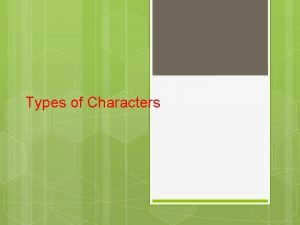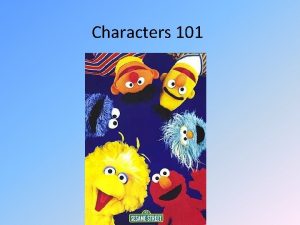Homeland Carrie Characters The lead protagonist is Carrie




- Slides: 4

Homeland Carrie -Characters- The lead protagonist is Carrie, a CIA agent. Our first encounter with her shows her in the field in Baghdad. She is presented in an active and dynamic way arguing with an authority figure and attempting to persuade a prisoner to pass on some information. Whilst in Baghdad some months before, she was told an American prisoner had been ‘turned’ and was loyal to the terrorist leader, Abu Nazir, so Carrie requests that the returning soldier is put under surveillance whilst the CIA and the media see Sgt Brody as a returning hero. Carrie represents a nonconventional and highly flawed hero. Not only is she a female who represents authority, a role usually taken by a male, she is also fiercely independent and has grit, determination and is happy to ignore the chain of command which alienates her from authority figures within the CIA. Brody is clearly disturbed by his experiences as a prisoner of war and the programme parallels his struggles in settling back in to a normal family life with Carrie’s psychological disintegration. What is representation? Representation is the action of presenting an individual, social group, social identity, event, issue or object in a certain way and from a particular point of view. It is REpresenting. The representation of anything will always depend on the viewpoint and intention of the maker of the representation thus reflecting their ideas and values as a result. Therefore, representations of the same event or social groups can differ as the political values and social position of the producer, and what they want to say, Propp’s character types can be different. Media Language • Levi Strauss • Barthes • Todorov • Neale • Baudrillard Representation • Gauntlett • Van Zoonen • Hall • Butler • Hooks • Gilroy Industries • Hesmondhalgh • Curran and Seaton • Livingstone and Lunt Audience • Bandura • Gerbner • Jenkins • Shirky • Hall • The hero • The helper • The villain • The donor • The false hero • The reward (princess) The complexity of Homeland The series immediately taps into post-9/11 issues as the surveillance of the returning solider is treated as both a problematic action and a necessity given the circumstances of his return. Carrie breaks the law in the name of national security in order to spy on Brody. This act is acknowledged and allowed by the authority figures at the CIA. Summary of technical conventions (media language) in long form TV dramas Camera (e. g. shot distance/angles/movement/framing) Editing (e. g. cuts/ transitions/special effects/motion/graphics and captions/pace) Mise-en-scène (e. g. location/setting/costume/makeup/props/performance/ lighting) Sound Diegetic/Non-Diegetic (e. g. musical score, incidental sound, sound effects/ sound bridge/wild sound/Foley)

The Killing -Characters. About the show The series is set in Copenhagen and revolves around Detective Inspector Sarah Lund (Sofie Gråbøl). Each fifty-minute episode covers twenty-four hours of the investigation. The Killing has proved to be an international hit—garnering significant critical acclaim —particularly in the United Kingdom, Germany and The Netherlands, receiving numerous awards and nominations including a BAFTA Award an International Emmy. Copenhagen Police Department detective Sarah Lund is looking forward to her last shift at work before moving to Sweden with her fiance, when her plans are thwarted. 19 -year-old Nanna Birk Larsen is missing and when her belongings are found in a field, Sarah suddenly finds herself at the head of a high-profile investigation, with leads reaching as far and high as the offices of a mayoral election candidate. Sarah heads the investigation and is teamed up with her replacement, Detective Inspector Jan Meyer. Theories of Gender Performativity Butler Gender is created in how we perform our gender roles – there is no essential gender identity behind these roles, it is created in the performance. Performativity is not a singular act but a repetition and a ritual that becomes naturalised within the body. Any feminism concerned only with masculinity and femininity excludes other forms of gender and sexuality. This creates ‘gender trouble’ for those that do not fit the heterosexual norms. Butler is an important postmodern writer and has influenced Queer theory – theory which deconstructs and aims to destabilise apparently fixed identities based on gender and sexualities. This theory shows the representations that exposes and disrupts heteronormativity; this is the belief that people fall into distinct and complementary genders (male and female) with natural roles in life Structuralism – Levi-Strauss thought that the human mind could be investigated by studying myths and fables from around the world. He developed the idea of the ‘binary opposition’ e. g. good-bad, malefemale, culture-nature, raw-cooked. Many writers have analysed media products using the idea of the binary opposition, but seeing the overall system as ‘ideology’ rather than ‘human consciousness’ About crime TV Dramas Crime drama is one of the most enduring, popular genres, not just on TV but also novels, films and theatre. They are distinguished by which aspects of law enforcement they focus on, for example a police inspector, a team of detectives, a psychologist or a lawyer. Crime dramas tend to be a male orientated genre, however, both Homeland The Killing have a female protagonist. Summary of technical conventions (media language) in long form TV dramas Camera (e. g. shot distance/angles/movement/framing) Editing (e. g. cuts/ transitions/special effects/motion/graphics and captions/pace) Mise-en-scène (e. g. location/setting/costume/makeup/props/performance/ lighting) Sound Diegetic/Non-Diegetic (e. g. musical score, incidental sound, sound effects/ sound bridge/wild sound/Foley)

Advertising and Marketing Old Spice ‘Smell like a man’ The Old Spice ‘Smell Like A Man’ campaign poster from 2010 was a transformative mass market campaign for the aftershave brand. Prior to 2010 the Old Spice brand was associated with a much older, more mature male audience. This magazine advert was a continuing part of a campaign that sought to reposition the brand make it more accessible to younger audiences. The campaign was so different from much of the formulaic work that prevailed at the time and helped convince other mainstream advertisers that they needed to push the boundaries if they were going to connect with a younger generation of consumer who had become desensitised to the effects of traditional marketing. What made its success all the more astonishing was that the campaign was for Old Spice, a neglected Procter & Gamble brand that had lost ground to rivals such as Axe (Lynx) and whose very name seemed to underline how outdated it had become. Lucozade ‘ I believe’ The Lucozade ‘I believe’ campaign poster from 2013 was part of a £ 4 m mass market campaign to educate consumers about how the soft drink brand can help improve people’s sports performance, and features footballer Gareth Bale as a key brand ambassador. Shelter, the UK based housing and homelessness charity launched an advertising campaign in 2011 that was produced for those at risk of homelessness to point them to Shelter’s free services and guide them to seek advice on issues around homelessness earlier. MEDIA LANGUAGE Refers to; media language elements, technology, genre, intertextuality and narrative. MEDIA REPRESENTATION Mediation, stereotypes, inequality in representation, themes and ideologies, representation and context and audience. MEDIA INDUSTRIES Media producers, ownership and control, convergence, funding, industries and audiences, media regulation, target audience, technology, active audiences, uses and gratification, changing audience responses The importance of advertising Advertising is the best way to communicate to the customers. Advertising helps informs the customers about the brands available in the market and the variety of products useful to them. Advertising is for everybody including both young and old. It is done using various media types, with different techniques and methods most suited. The adverts shown are all done via print. Advertising has crucial role in todays competitive marketing world. There is Creative Advertising and Marketing Management is necessary in order to have a complete understanding of how producers and sales companies work effectively

Term 1 – Practical Content Workspace: Below is the workspace area for Photoshop PHOTOSHOP is a digital photo editing software created by Adobe. You will find that all Adobe packages follow a similar house style CMYK vs RGB CMYK: Cyan, Magenta, Yellow, and Black are the colours used when images are being printed. Therefore when work is going to be printed make sure it is adjusted to CMYK in the settings. RGB: Red, Green and Blue are the colours used when images are viewed onscreen. A View tools B Select tools C Enhance tools D Draw tools Types of graphics WHAT IS A BITMAP GRAPHIC? When you take a photograph using a digital camera or scan an image the image shown is bitmap. A bitmap graphic is composed of many tiny parts, called pixels, which are often many different colours. It is possible to edit each individual pixel. Bitmap graphics are often quite large. When you resize a bitmap graphic, it tends to lose quality. WHAT IS A VECTOR GRAPHIC? Vector graphics are created in graphics packages and consist of shapes called objects. Vector graphics are scalable - i. e. when you resize them, they do not lose quality. There are many standard formats for saving bitmaps. Below are examples of some of the most common files: E Modify tools F Colour GIF is a common format for images that appear on Web pages. JPEG is a compression scheme that works well for natural scenes such as scanned photographs. PNG format retains many of the advantages of the GIF format but also compresses files without the loss of data. Layers within Photoshop There are many features within Photoshop that you will discover. Some examples are shown here. ENHANCING TOOLS If you have a slightly blurry image, use the ‘SHARPEN’ tool to make an image look sharper. Whilst the ‘BLUR’ tool will make your image become blurry. In Photoshop, layers are used to work on individual parts of an image whilst not affecting other parts. They allow you to modify your image, add text, change colours, put two pictures on the same page, and more without modifying your original photo. Photoshop layers are like sheets of stacked acetate. You can see through certain parts of a layer to the layer below. There are different type of layers within Photoshop, these include: ADJUSTMENT LAYER This layer allows you to create a transparent layer where you can make direct changes to your photograph without making any changes to your original. TEXT LAYER This allows you to add text to your image. You can change the font, colour, size and shape of text. DUPLICATE LAYER This layer will create a duplicate copy of whatever layer you are on. This sharpens the image or layer you are currently working on. SELECTION TOOLS The ‘CLONE’ tool allows you to copy one area of the layer to another area of the layer. The ‘MAGIC WAND’ selects pixels based on tone and colour. The ‘QUICK SELECTION’ is somewhat similar to the Magic Wand but also looks for similar textures in the image.







